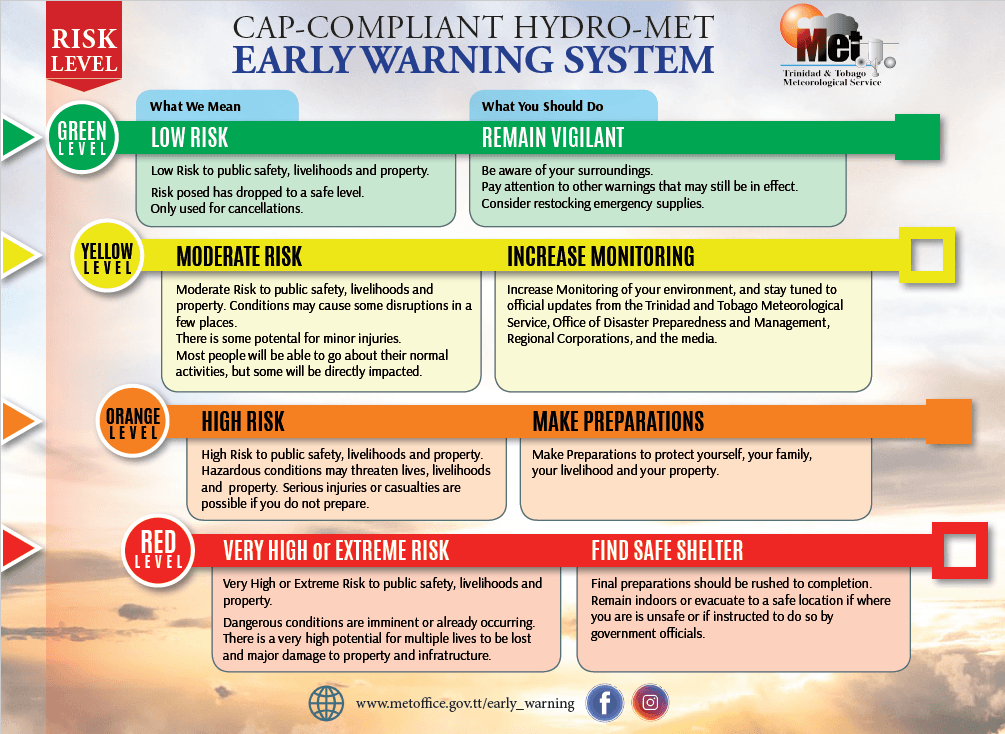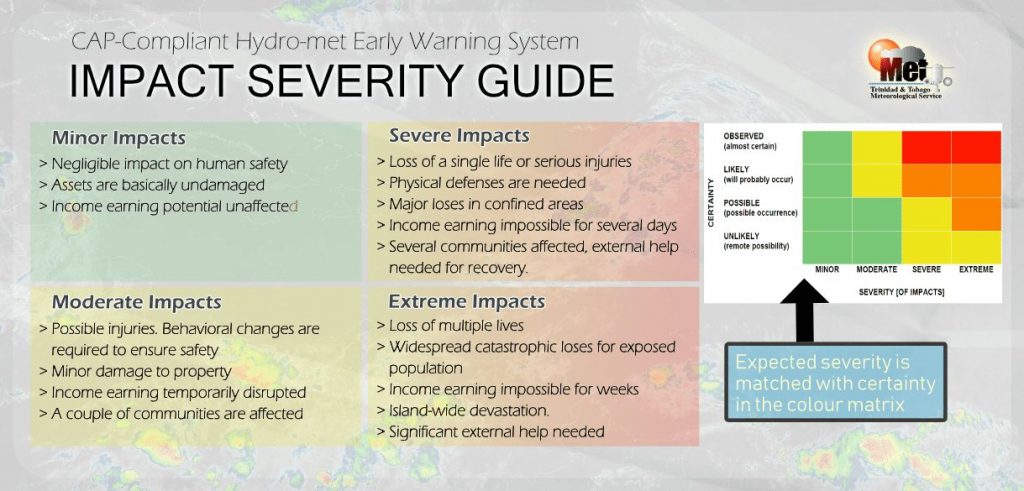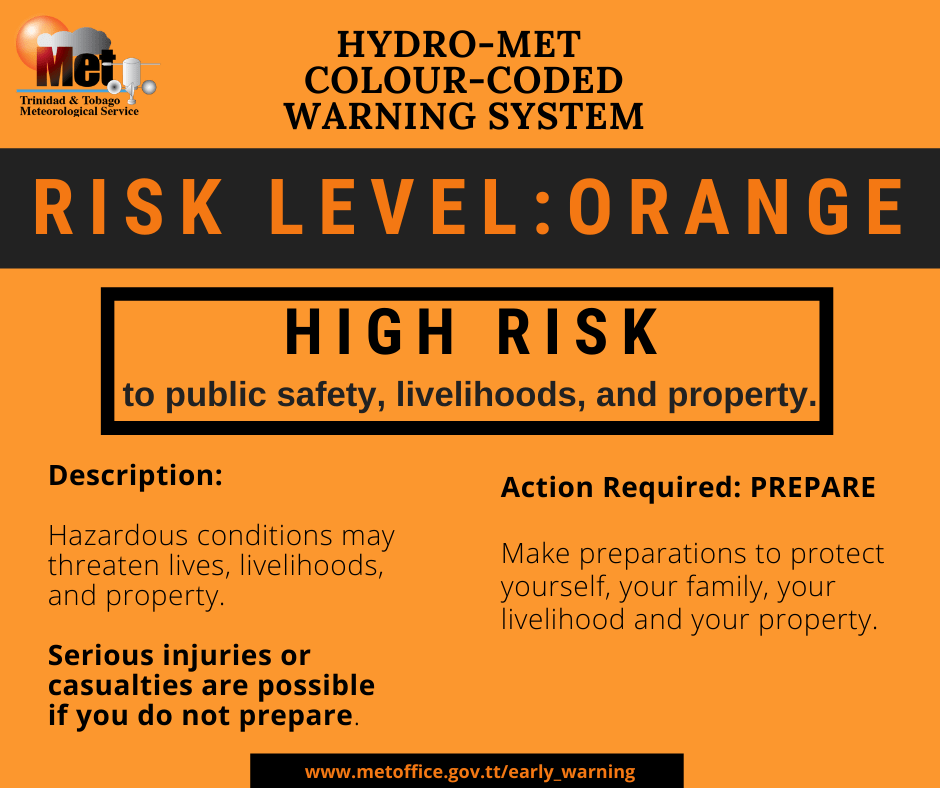Hurricane Beryl has moved across the Windward Islands as a powerful Category 4 Hurricane with maximum sustained winds of 240 KM/H. As this hurricane moves into the eastern Caribbean Sea, the Trinidad and Tobago Meteorological Service has downgraded the Red-Level Hurricane Warning to an Orange-Level Tropical Storm Warning.
As of 12:00 PM (noon) today, Hurricane Beryl was located near 12.6°N 61.9°W, approximately 60 kilometers north-northwest of Grenada, moving west-northwestward near 31 KM/H.
For Tobago, according to the Trinidad and Tobago Meteorological Service, “The potential for hurricane force winds has decreased significantly as Hurricane Beryl moves away from the island. The possibility of impacts from tropical storm force winds still exists.” as of 11:32 AM Monday.
Trinidad’s Tropical Storm Warning was downgraded to an Orange-Level Adverse Weather Alert.
What you need to know
— Rainfall: Through Thursday morning, across Trinidad, rainfall accumulations between 25 and 50 millimeters are likely, while across Tobago, accumulations between 25 and 75 millimeters are likely, with isolated totals favoring the northern half of Trinidad and Tobago exceeding 150 millimeters, particularly where feeder band activity develops.
— Hazards: Several hazards are forecast. According to the TTMS: “Periods of showers and extended periods of rain are expected. Gusty winds are expected in heavy showers and thunderstorms that can still occur. The likelihood of landslides remains in areas so prone.”
— Marine: According to the TTMS, “Hazardous seas have been observed with large, battering waves, and mariners should continue to expect significant wave heights, posing danger to small craft, coastal and offshore activities. Strong currents and choppy seas will make navigation hazardous.”
Latest Alerts
TTMS Issues Adverse Weather Alert For T&T
Trinidad and Tobago is NOT under any tropical storm or hurricane threat, watch, or warning at this time.
The Tropical Storm Warning
The Trinidad and Tobago Meteorological Service has issued a Tropical Storm Warning, downgrading from the Hurricane Warning, for Tobago and surrounding coastal waters. This warning was updated at 11:32 AM Monday. According to the Trinidad and Tobago Meteorological Service, it will remain in effect until 3:00 PM on Monday, July 1st, 2024.


“The Hurricane Warning for Tobago has been downgraded to a Tropical Storm Warning. At 11:00 AM, Hurricane Beryl was located at 12.4N latitude, 61.3 W longitude. The potential for hurricane-force winds has decreased significantly as Hurricane Beryl moves away from the island. The possibility of impacts from tropical-storm-force winds still exists. Periods of showers and extended periods of rain are expected. Gusty winds are expected in heavy showers and thunderstorms that can still occur. The likelihood of landslides remains in areas so prone. Hazardous seas have been observed with large, battering waves, and mariners should continue to expect significant wave heights, posing danger to small craft and coastal and offshore activities. Strong currents and choppy seas will make navigation hazardous.” according to the Trinidad and Tobago Meteorological Service.
Why am I under a tropical storm watch or warning?
A tropical storm warning is an announcement that sustained winds of 34 to 63 knots (39 to 73 mph or 63 to 118 km/hr) are expected somewhere within the specified area within 36 hours in association with a tropical, subtropical, or post-tropical cyclone.
A tropical storm watch is an announcement that sustained winds of 34 to 63 knots (39 to 73 mph or 63 to 118 km/hr) are possible within the specified area within 48 hours in association with a tropical, subtropical, or post-tropical cyclone.
This specific watch or warning is based on the potential for experiencing tropical-storm-force winds alone, not the other hazards associated with a tropical storm (hazardous seas, torrential rainfall, etc.). This means if the system tracks close to your country, but the strongest winds remain offshore or north/east of your location, you may not be placed under a tropical storm watch or warning, but you may have other advisories in effect.

The color of the warning indicates the severity of the event and the probability of the event occurring. Currently, the warning level is orange. This means that the hazards are likely, and the severity of impacts is severe for this particular warning. For the island of Tobago, the public should prepare for the hazards associated with tropical-storm-force winds and gusts, street/flash flooding, frequent lightning in thunderstorms, and landslides. Seas will also become hazardous, and mariners should prepare for large waves in nearshore areas, particularly Atlantic-facing coastlines, as well as ongoing storm surge.
At an Orange Level, there is a high risk to public safety, livelihoods and property with hazardous conditions threatening lives, livelihoods, and property. According to the TTMS guidance on their Early Warning System, at this level, serious injuries or casualties are possible if you do not prepare.
The TTMS says severe impacts are possible. This means that conditions may result in the loss of a single life or serious injuries, physical defenses are needed, major losses in confined areas, and income earning impossible for several days, with several communities being affected. External help is needed for recovery.
The public, according to the TTMS, should: “Continue to take actions to protect their lives, livelihoods, and property. Shelter in place until the danger passes. Avoid wading through residual flood water. Avoid dangerous areas as residual risks of flooding and landslides exist. Sea bathers, fishermen, small craft operators, and other coastal interests should be fully prepared to protect lives, livelihoods, and coastal property. Exercise extreme caution along the coast. Avoid entering the sea. Be prepared for dangerous breaking waves and currents. Follow the instructions of (the) lifeguards. Monitor official news sources and weather updates. Follow instructions of government officials.”











